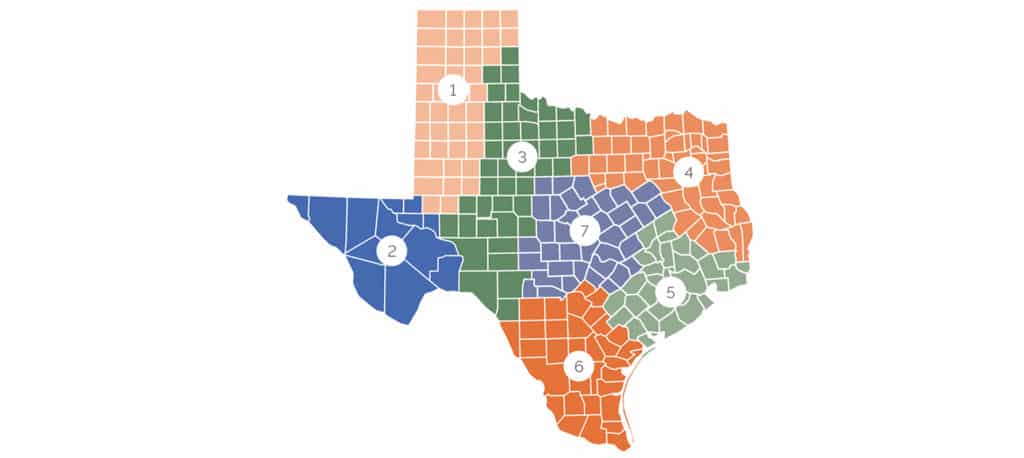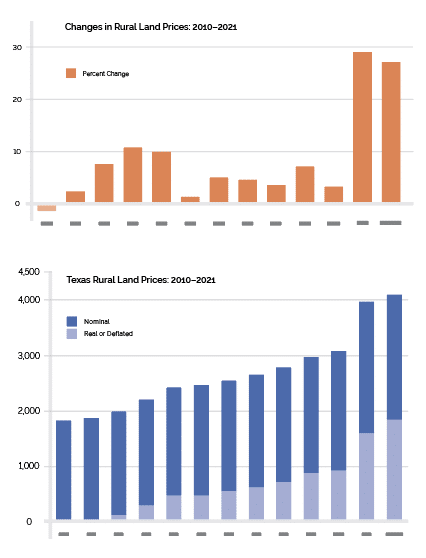

This article is featured in the Fall 2022 issue of Texas LAND magazine. Click here to find out more.
As 2022 unfolded, the first quarter annualized volume of sales fell 7.67 percent to 8,166 compared to the first quarter 2021. First quarter of 2022 quarter-only totals dropped from 2,839 in 2021 to 1,950 in 2022, a 31.31 percent slide. However, the 2021 first quarter annualized total was a 28.21 percent increase over the pre-pandemic 2019 volume. Reported preliminary sales annualized volume for the second quarter suggest that it will be the third straight quarter with declines in activity. However, brokers report a brisk level of business despite rising interest rates and volumes continue to exceed 2019 totals.

Continued interest in rural properties drove preliminary second quarter prices up 22.64 percent to $4,257 per acre statewide. That represents a reduction from the 27.12 percent rate posted in the first quarter and a retreat from the recent high of 29.05 percent in 2021 quarter four. The slowdown in the rate of increase suggests that price pressures may have eased slightly in 2022.
The preliminary total dollar volume at $3.508 billion exceeded 2021 levels by 23.22 percent. That total will increase when the final reports are recorded.
Preliminary acreage reports totaled 824,180 acres, even with the 2021 second quarter total. However, final numbers will represent an increase in acreage. The typical size expanded 9.69 percent to 1,297 acres.
All regions posted strong price increases except for Far West Texas where prices declined. In addition, the Panhandle and South Plains, Far West Texas, and West Texas regions posted substantial increases in total acres sold.

- Panhandle & South Plains. Prices rose 19.21 percent during the second quarter to $1,384 per acre and total acres moved up 28.85 percent to 198,835 acres. The number of sales dropped 21.95 percent to 441 sales. Total dollar volume was up 53.59 percent to $275.2 million.
- Far West Texas. Activity remained sparse with only 26 reported sales in this region. However, those sales pushed total acreage up 48.57 percent to 43,161 acres. Prices slipped down 30.19 percent to $1,096 per acre. Few sales at historically very high prices makes it difficult to establish reliable market-wide pricing information.
- West Texas. Sales activity declined 28.54 percent to 874 sales, but prices rose 20.76 percent to $2,135 per acre. Total acreage increased 22.50 percent to 272,066 acres. At $580.9 million, total dollar volume increased 47.93 percent. Strong demand fueled higher prices.
- Northeast Texas. Volume declined 37.25 percent to 1,910 sales with prices increasing 27.88 percent to $7,435 per acre. Total acreage declined 38.64 percent to 69,344 acres. Rising prices were not enough to prevent total dollar volume from declining 21.53 percent to $515.6 million. Final reports will reduce the declining volume statistics.
- Gulf Coast–Brazos Bottom. Volume also dropped in this region, down 27.85 percent to 935 sales. In addition, total acres dropped 7.12 percent to 47,397 acres. Prices increased a substantial 20.79 percent to $9,099 per acre. The high price sent total dollar volume up 12.19 percent to $431.3 million.
- South Texas. Sales activity flagged in the region south of San Antonio, falling 20.50 percent to 671 sales. Acreage receded 21.98 percent to 69,887 acres. Prices grew 18.24 percent to $5,069 per acre. This activity drove total dollar volume down 7.74 percent to $354.3 million. Final reports will soften the volume declines.
- Austin-Waco-Hill Country. Prices in central Texas topped 2021 prices by 39.43 percent, rising to $6,645 per acre. In addition, dollar volume inched up 6.78 percent to $820.6 million. Total acres sold dropped 23.42 percent to 123,489 acres.
The Future
The explosion in the volume of transactions in rural property appears to have slowed from the feverish pace last year as Federal Reserve interest rate increases and general inflation reduced disposable incomes. In addition, prospective buyers find few properties for sale. Investors, a throng of buyers motivated by the desire to own rural retreats, and farmers and ranchers continue to compete for a limited supply of available properties.
Observers report evidence that the number of listings is increasing while the number of transactions has slowed. The coming months will likely see robust demand but a more relaxed pace of sales. Prices should continue to increase.